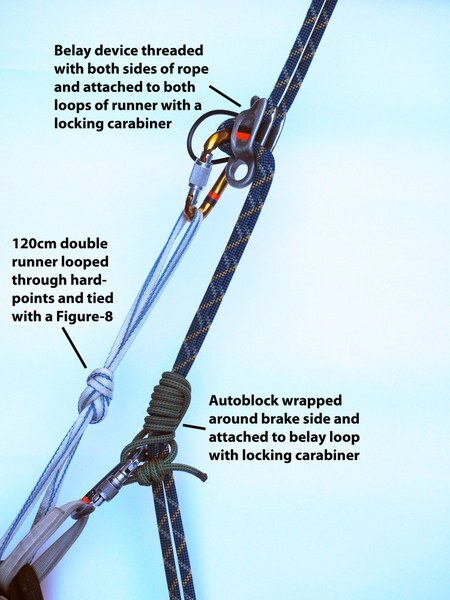Basic rappell extension question
|
|
Hello! I have a quick question regarding a rappel extension constructed using a 120cm sling. For reference, this is a picture taken from this guide on setting up an extended rappel. What is the rationale behind using a single 120cm sling threaded through the harness tie-in points via basket hitch with a figure 8 roughly halfway through? The site says this:
I don't quite understand the following:
Thank you. |
|
|
Theres a million and one ways to extend a rappel. The picture shown is just one of the more common ways. If by some incredibly unlikely event rockfall came down and cut through your rappel extension, having it doubled up and tied in the middle means that you have redundancy on both sides of the knot. With no knot, a cut anywhere on the extension would drop you onto your auto block (if it would even hold you). The same thing could be achieved with two 60 cm slings, yes but that is uncommon to see. A convenient, but bulky and heavy, solution that I like is a dedicated dog bone (the thick nylon part of a quickdraw) with lockers on both ends. Clip it to your belay loop and the rappel device and you're good to go, no knots or hitches to fuss around with and dog bones can stand up to a lot more abrasion than those skinny slings in the picture. |
|
|
I often just girth hitch a single sling. I'm not sure what they mean by "more susceptible to failure" except that it will break at around 11kn compared to 22kn for the doubled up knotted sling, but 11kn is strong enough. |
|
|
I just noticed that this is in the sport climbing forum. I never rappell when single pitch climbing. Lowering is a better way to get down. I bring mussy hooks and add them to routes that aren't equipped for lowering already. |
|
|
I was advised to rappel down in cases where the lowering hardware is old, in order to preserve what little life it has left. I acknowledge that lowering down is much much safer. In my case while I'll likely never need to rappel down, I was again advised that it is a good idea to know how.
Thank you, this is exactly what I was wondering! |
|
|
J L wrote: If you are girth hitching a 60cm will be too long without the knot in the middle. And using two would be too much cluster for my taste. My go to is a single basket hitched 60m sling. Just the right length, fast to setup, no knots to untie. Learned this setup from a clinic put on by the writers of the Mountain Guide Manual. As stated by the guide: "There are times redundancy is needed. This isn't one of them." Given that rappelling accidents occur every year, mostly due to incorrect rigging, there is great value in keeping it simple and easy to inspect. The method in your pic is fine too. |
|
|
Here is another consideration helpful on multiple rappels. If you girth hitch the 120 to your belay loop and clip the atc to an overhand knot slightly less than half the length of the sling, then you can put a locker at the far end of the sling and use that to clip in to the next rappel anchor when you get there. This allows you to unthread your rappel device, your partner to rap- all while being clipped to the anchor and off the rope. You can also weight the next rap setup to test that you have threaded the atc correctly, that the rope is secure in the anchor, and that your third hand will actually catch you if you weight it— all this before unclipping the leash locker. This is a very important safety step. |
|
|
J L wrote: Just saw this thread. I wrote up the underlying procedure that your link/document quoted. This method of extension was designed for trad climbing in the Washington Cascades. The purpose of the DOUBLED sling with FIGURE-8 was to provide strand redundancy when using tied slings. Tied doubles were an acceptable option for the users. The figure-8 also cleanly trapped the carabiner for clipping to the harness. The 120 cm LENGTH ended up being right for most people. 60 cm was easier to inspect and would have been my personal choice where redundancy was deemed less important, such as where only wider, sewn slings would be used. |
|
|
Marco Velo wrote: What you say is true, especially for bolted rap stations. The OP's linked procedure was intended for trad climbing in the WA Cascades, where there can be some funky rap anchors that require a longer and independent PA. |
|
|
Hey, thanks for responding! Nice to hear from the original author of the guide. Since I posted this topic, I still have not had occasion to rap anywhere the most likely for simpler sport situations , I would just basket hitch a single length as Andrew suggested. |

 Continue with onX Maps
Continue with onX Maps Sign in with Facebook
Sign in with Facebook




















